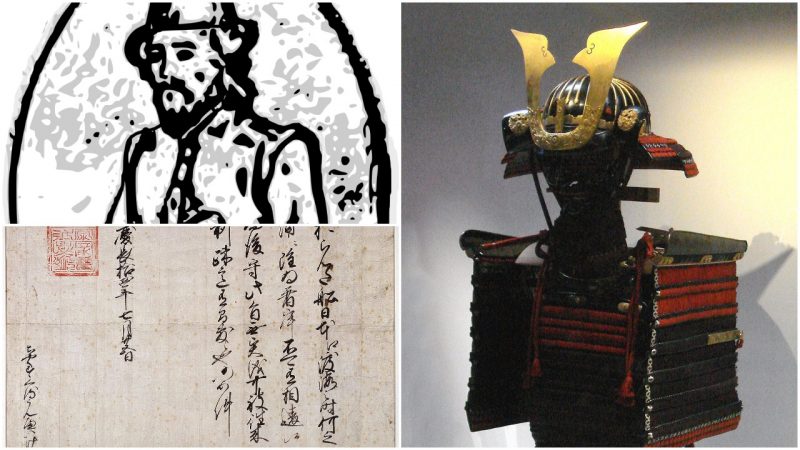William Adams, known in Japanese as Miura Anjin or “the pilot of Miura,” was an English navigator who in 1600 was the first of his nation to reach Japan. One of a few survivors of the only Dutch East India Company ship to reach Japan from a five-ship expedition of 1598, Adams settled there and became the first ever (and one of the very few) Western Samurai.
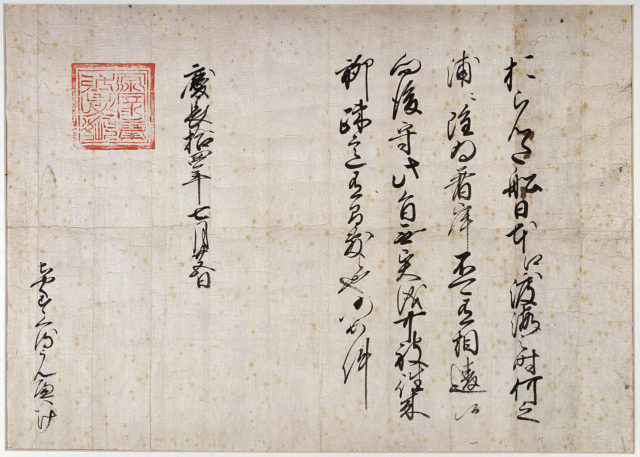
In April 1600, after more than nineteen months at sea, a crew of about twenty sick and dying men (out of the 100 who started the voyage) brought the Liefde to anchor off the island of Kyūshū, Japan. Its cargo consisted of eleven chests of trade goods: coarse woolen cloth, glass beads, mirrors, and spectacles; and metal tools and weapons: nails, iron, hammers, nineteen bronze cannons; 5,000 cannonballs; 500 muskets, 300 chain-shot, and three chests filled with coats of mail.
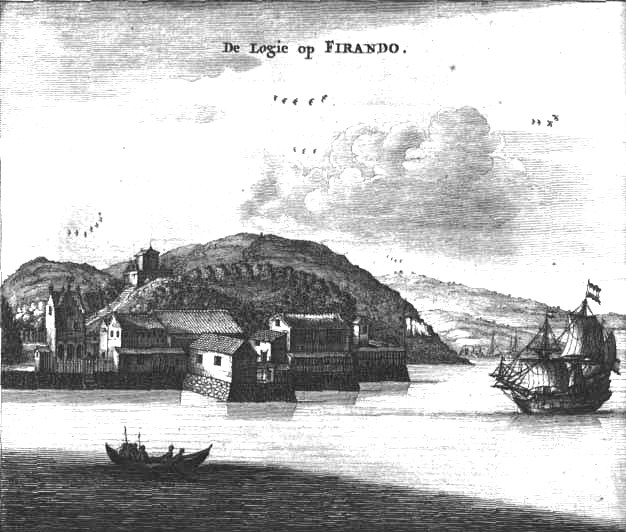
When the nine surviving crew members were strong enough to stand, they made landfall on 19 April off Bungo (present-day Usuki, Ōita Prefecture). They were met by Japanese locals and Portuguese Jesuit missionary priests claiming that Adams’ ship was a pirate vessel and that the crew should be executed as pirates. The ship was seized, and the sickly crew imprisoned at Osaka Castle on the orders of Tokugawa Ieyasu, the daimyo of Edo and future Shogun. The nineteen bronze cannon of the Liefde were unloaded and, according to Spanish accounts, later used at the decisive Battle of Sekigahara on 21 October 1600.
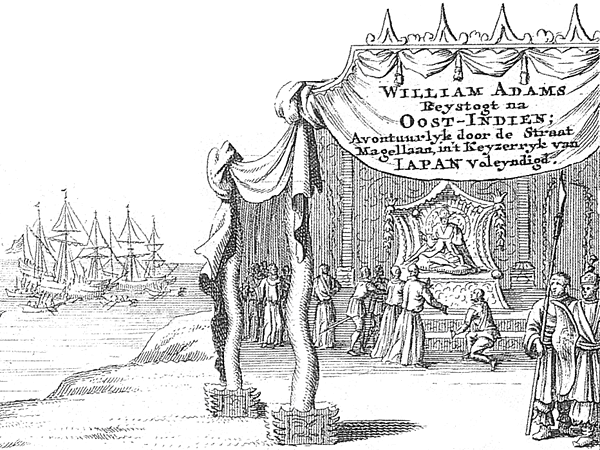
Adams met Ieyasu in Osaka three times between May and June 1600. He was questioned by Ieyasu, then a guardian of the young son of the Taikō Toyotomi Hideyoshi, the ruler who had just died. Adams’ knowledge of ships, shipbuilding and nautical application of mathematics appealed to Ieyasu.
Coming before the king, he viewed me well, and seemed to be wonderfully favourable. He made many signs unto me, some of which I understood, and some I did not. In the end, there came one that could speak Portuguese. By him, the king demanded of me of what land I was, and what moved us to come to his land, being so far off. I showed unto him the name of our country, and that our land had long sought out the East Indies, and desired friendship with all kings and potentates in way of merchandise, having in our land diverse commodities, which these lands had not… Then he asked whether our country had wars? I answered him yea, with the Spaniards and Portugals, being in peace with all other nations. Further, he asked me, in what I did believe? I said, in God, that made heaven and earth. He asked me diverse other questions of things of religions, and many other things: As what way we came to the country. Having a chart of the whole world, I showed him, through the Strait of Magellan. At which he wondered, and thought me to lie. Thus, from one thing to another, I abode with him till mid-night. (from William Adams’ letter to his wife)
Adams wrote that Ieyasu denied the Jesuits’ request for execution on the ground that:
we as yet had not done to him nor to none of his land any harm or damage; therefore against Reason or Justice to put us to death. If our country had wars the one with the other, that was no cause that he should put us to death; with which they were out of heart that their cruel pretence failed them. For which God be forever praised. (William Adams’ letter to his wife)
Ieyasu ordered the crew to sail the Liefde from Bungo to Edo where, rotten and beyond repair, she sank.
In 1604, Tokugawa ordered Adams and his companions to help Mukai Shogen, who was commander-in-chief of the navy of Uraga, to build Japan’s first Western-style ship. The sailing ship was built at the harbor of Ito on the east coast of the Izu Peninsula, with carpenters from the harbor supplying the manpower for the construction of an 80-ton vessel. It was used to survey the Japanese coast. The Shogun ordered a larger ship of 120 tons to be built the following year; it was slightly smaller than the Liefde, which was 150 tons. According to Adams, Tokugawa “came aboard to see it, and the sight whereof gave him great content”. In 1610, the 120-ton ship (later named San Buena Ventura) was lent to shipwrecked Spanish sailors. They sailed it to Mexico, accompanied by a mission of twenty-two Japanese led by Tanaka Shōsuke.
Following the construction, Tokugawa invited Adams to visit his palace whenever he liked and “that always I must come in his presence.”
Other survivors of the Liefde were also rewarded with favors, and were allowed to pursue foreign trade. Most of the survivors left Japan in 1605 with the help of the daimyo of Hirado. Although Adams did not receive permission to leave Japan until 1613, Melchior van Santvoort and Jan Joosten van Lodensteijn engaged in trade between Japan and Southeast Asia and reportedly made a fortune. Both of them were reported by Dutch traders as being in Ayutthaya in early 1613, sailing junks filled with cargo.
Around 1608 Adams contacted the interim governor of the Philippines, Rodrigo de Vivero y Velasco, on behalf of Tokugawa Ieyasu, who wished to establish direct trade contacts with New Spain. Friendly letters were exchanged, officially starting relations between Japan and New Spain. Adams is also recorded as having chartered Red Seal Ships during his later travels to Southeast Asia. (The Ikoku Tokai Goshuinjō has a reference to Miura Anjin receiving a shuinjō, a document bearing a red Shogunal seal authorizing the holder to engage in foreign trade, in 1614.)
Taking a liking to Adams, the Shogun appointed him as a diplomatic and trade advisor, bestowing great privileges upon him. Ultimately, Adams became his personal advisor on all things related to Western powers and civilization. After a few years, Adams replaced the Jesuit Padre João Rodrigues as the Shogun’s official interpreter. Padre Valentim Carvalho wrote: “After he had learned the language, he had access to Ieyasu and entered the palace at any time”; he also described him as “a great engineer and mathematician.”
Adams had a wife and children in England, but Ieyasu forbade the Englishman to leave Japan. He was presented with two swords representing the authority of a Samurai. The Shogun decreed that William Adams the pilot was dead and that Miura Anjin, a samurai, was born. According to the Shogun, this action “freed” Adams to serve the Shogunate permanently, effectively making Adams’ wife in England a widow. (Adams managed to send regular support payments to her after 1613 via the English and Dutch companies.) Adams also was given the title of hatamoto (bannerman), a high-prestige position as a direct retainer in the Shogun’s court.
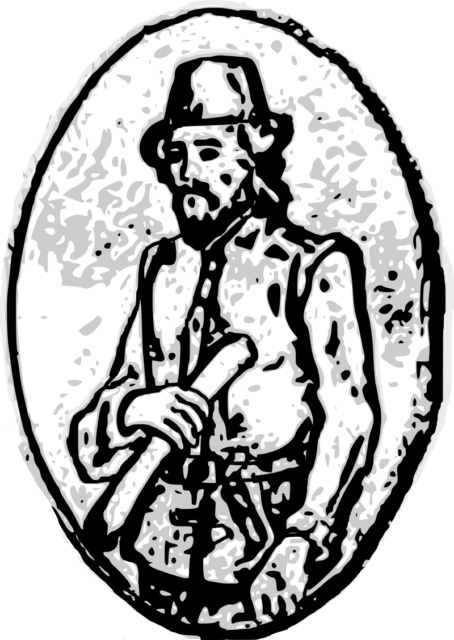
Adams was given generous revenues: “For the services that I have done and do daily, being employed in the Emperor’s service, the emperor has given me a living” (Letters). He was granted a fief in Hemi within the boundaries of present-day Yokosuka City, “with eighty or ninety husbandmen, that be my slaves or servants” (Letters). His estate was valued at 250 koku (a measure of the yearly income of the land in rice, with one koku defined as the quantity of rice sufficient to feed one person for one year). He finally wrote, “God hath provided for me after my great misery” (Letters), by which he meant the disaster-ridden voyage that had initially brought him to Japan.
Adams’ estate was located next to the harbor of Uraga, the traditional point of entrance to Edo Bay. There he was recorded as dealing with the cargo of foreign ships. John Saris related that when he visited Edo in 1613, Adams had resale rights for the cargo of a Spanish ship at anchor in Uraga Bay.
Adams’ position gave him the means to marry Oyuki, the daughter of Magome Kageyu. He was a highway official who was in charge of a packhorse exchange on one of the grand imperial roads that led out of Edo (roughly present-day Tokyo). Although Magome was important, Oyuki was not of noble birth, nor high social standing. Adams may have married from affection rather than for social reasons. Adams and Oyuki had a son Joseph and a daughter Susanna. Adams was constantly traveling for work. Initially, he tried to organize an expedition in search of the Arctic passage that had eluded him previously.
Adams had a high regard for Japan, its people, and its civilization:
The people of this Land of Japan are good of nature, curteous above measure, and valiant in war: their justice is severely executed without any partiality upon transgressors of the law. They are governed in great civility. I mean, not a land better governed in the world by civil policy. The people be very superstitious in their religion, and are of diverse opinions
